Tech
Space calendar 2025: Here are the moments you wont want to miss
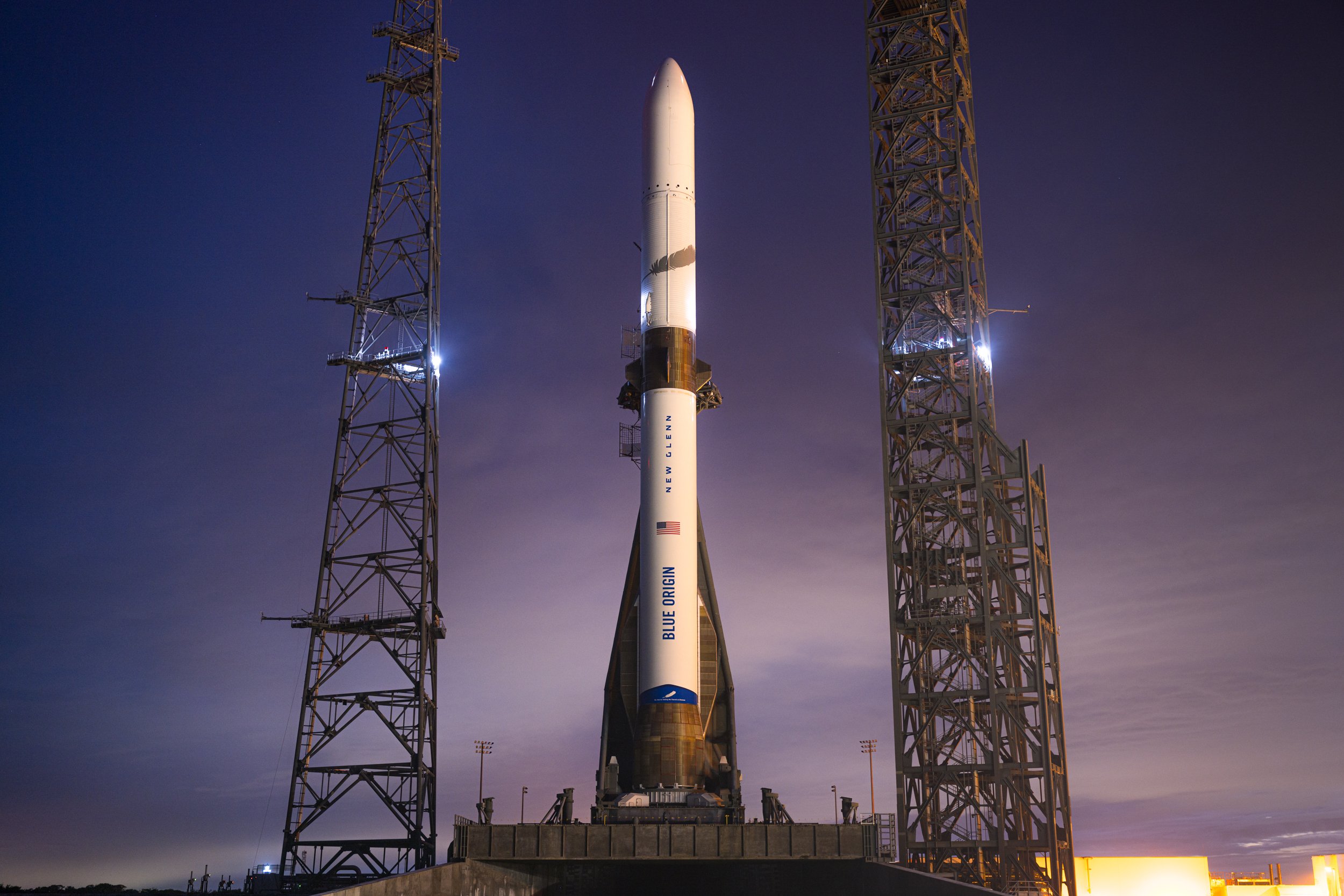
Though 2025 won't mark the return of astronauts into deep space as NASA had hoped, launchpads still will be scorching-hot from a procession of robotic spacecraft attempting to land on the moon.
How many of these moon landings will succeed? Will the number top the two-ish (one of which made a heckuva comeback) last year?
Giant commercial rockets, such as SpaceX's Starship and Blue Origin's New Glenn, will likely also have several uncrewed orbital test launches as they iron out the kinks in their hardware. And while people await scientific missions to distant solar system destinations, a few probes will send home close-up pictures of planets as they snag gravitational boosts from flybys.
Here's a round-up of space missions and cosmic events just around the bend. Bookmark this calendar and look for updates from Mashable throughout the year.
BepiColombo makes final Mercury flyby: Jan. 8
Mercury is the closest planet to the sun, but it's perhaps the most overlooked of the rocky worlds in the solar system. Hot and harder to reach than Saturn, it hasn't enjoyed the level of study that other worlds have.
But BepiColombo, a joint mission of the European and Japanese space agencies, seeks to change that. The spacecraft makes its sixth and final flyby on Jan. 8 before returning to enter orbit around the planet in late 2026. Closest approach will take the spacecraft just 160 miles above the surface of Mercury. Mission controllers will release images of the event on Jan. 9.
Two moon landers on one rocket: Jan. 15
Two small uncrewed spacecraft, one of which is carrying several NASA instruments, will try to land on the moon with a boost from the same rocket.
Both Firefly Aerospace and Japan's ispace will ride a SpaceX Falcon 9 rocket slated to leave Earth as early as 1:11 a.m. ET Jan. 15. Firefly's Blue Ghost lander was originally scheduled to lift off in late 2024, and the launch will mark its maiden voyage. The spacecraft is slated to travel for 45 days before trying to touch down in early March.
Firefly's flight will be the first Commercial Lunar Payload Services mission of the year. The NASA program has recruited vendors from the private sector to help deliver instruments to the moon and send back crucial data.
Ispace's new Hakuto-R mission will be its second try, after it ran out of fuel and crashed on the lunar surface in April 2023. The Resilience lander, a partnership with Japan's space agency JAXA, is taking a long way to the moon to save on fuel, arriving about four to five months after launch.
Blue Origin's first flight for New Glenn: Jan. 16
Amazon founder Jeff Bezos will soon get a chance to see his giant rocket New Glenn launch from Cape Canaveral, Florida.
His aerospace company Blue Origin started a countdown on Jan. 13, but launch controllers waved off the opportunity when a technical issue arose. The company will try again no earlier than Jan. 16, targeting a three-hour launch window that opens at 1 a.m. ET.
Blue Origin's goal is to reach orbit, and the company will also try to land its booster on a barge in the Atlantic Ocean so that it can be reused on future flights, though executives admit doing so would be "ambitious" on the first try.
SpaceX tests upgraded Starship: Jan. 16
SpaceX is preparing to launch another uncrewed Starship test, this time with an upgraded spacecraft and 10 mock satellites to practice a payload deployment in space.
This SpaceX launch would mark the seventh Starship test and feature a reused engine from the booster returned from the fifth test. Weather-related postponements have made it possible that Starship and Blue Origin's New Glenn will lift off for these tests on the same day. Starship's one-hour launch window opens at 4:00 p.m. CT.
NASA moon rover and orbiter delivery: Feb. 26
Intuitive Machines made history last year as the first company to reach the moon intact — though its lander, Odysseus, broke a landing leg and touched down tilted.
The Houston-based company is now gearing up for a second moon landing — this time with the Athena lander. The mission, referred to as IM-2 or PRIME-1, will carry a NASA rover. The spacecraft will test a drill and mass spectrometer, a device that identifies the kinds of particles in a substance. Liftoff is targeted for a four-day launch window that opens no earlier than 7:02 p.m. ET Feb. 26.
Another spacecraft, NASA's Lunar Trailblazer, will also hitch a ride on this flight. The small satellite will orbit the moon to map out the locations of lunar water.
Europa Clipper flies by Mars: Feb. 27
After a successful October 2024 launch, the Europa Clipper spacecraft has been hurtling through space. It's on schedule to make its first flyby of Mars on Feb. 27, where it will get a gravity assist to continue its journey. The craft won't arrive at Europa, one of Jupiter's moons, for its mission until 2030.
Scientists are intrigued by Europa because they believe it could hold double the water held by Earth's oceans. Could this small world in the outer solar system have conditions capable of supporting life? If NASA finds that Europa is a habitable place, a second Europa mission could return to determine if there are indeed any inhabitants.
Launch of new astrophysics observatory: Feb. 28
NASA intends to launch an astrophysics observatory to create a map of the entire sky in 3D. The mission, SPHEREx (Spectro-Photometer for the History of the Universe, Epoch of Reionization and Ices Explorer), will orbit Earth while studying hundreds of millions of stars and galaxies, showing them in 102 invisible "colors."
One of the main goals of the mission is to learn more about cosmic inflation, a brief but crucial phase of the Big Bang that contributed to the universe's expansion. It will launch on a SpaceX Falcon 9 from Vandenberg Space Force Base in California as early as 7:09 p.m. PT on Feb. 28. NASA’s PUNCH (Polarimeter to Unify the Corona and Heliosphere) probe is hitching a ride on the same rocket and will be the first to image the sun’s corona and solar wind together to better understand them as a connected system.
SpaceX tests Starship following explosion: Feb. 28
Coming off the heels of a Starship test that ended in an explosion, SpaceX will try to fly the rocket and empty spacecraft again as early as Feb. 28.
The upcoming launch will be the eighth for Starship and feature several hardware changes following January's mishap. During the previous test, two flashes occurred near one of the ship's engines shortly after booster separation. A post-flight investigation determined that strong vibrations led to fuel leaks that were too much for the ship's vents to handle, leading to fires that eventually triggered the flight termination system.
Firefly attempts moon landing: March 2
Following a successful launch in January, Firefly Aerospace will target a robotic landing in the Mare Crisium region of the moon, an ancient hardened lava flow, at 3:45 a.m. ET on March 2. Prior to descent onto the surface, NASA and Firefly intend to broadcast commentary, starting at 2:30 a.m. ET that morning. However, the broadcast will not include a live video stream of the spacecraft.
"Our available bandwidth will be dedicated to critical descent operations during landing," Firefly officials said on X, formerly called Twitter.
Landing on the moon remains onerous. The moon's exosphere provides virtually no drag to slow a spacecraft down as it approaches the ground. Furthermore, there are no GPS systems on the moon to help guide a craft to its landing spot.
Blue Ghost shared a ride on a SpaceX Falcon 9 rocket with the Japanese company ispace, which will try to land on the moon after a failed attempt in 2023. Its Resilience lander is taking a longer route than Blue Ghost to save on fuel, arriving in May or June.
Intuitive Machines attempts moon landing: March 6
On the heels of Firefly Aerospace's moon landing attempt, competitor space company Intuitive Machines will try to touch down just four days later.
Though neither the company nor NASA has released a specific time yet, the landing is slated for March 6. The company's lander, Athena, will attempt to descend on Mons Mouton, a plateau at the moon's south pole. Befor landing, the spacecraft is expected to orbit the moon for about one week.
European spacecraft Hera flies by Mars: March 12
Back in 2022, NASA deliberately crashed a spacecraft into a harmless asteroid to practice thwarting a space rock, should a hazardous one ever be on a collision course with Earth.
The European Space Agency is providing a follow-up to that test, known as Hera. The mission's spacecraft launched in October 2024 and will rendezvous with Dimorphos, the slammed asteroid, in 2026. But this March, it will also have a quick pop-in with Mars, closest approach at 7:51 a.m. ET, and one of the Red Planet's two moons, Deimos. Mission controllers will use the opportunity to collect data on the Martian moon.
Boeing astronaut crew returns home: mid-March
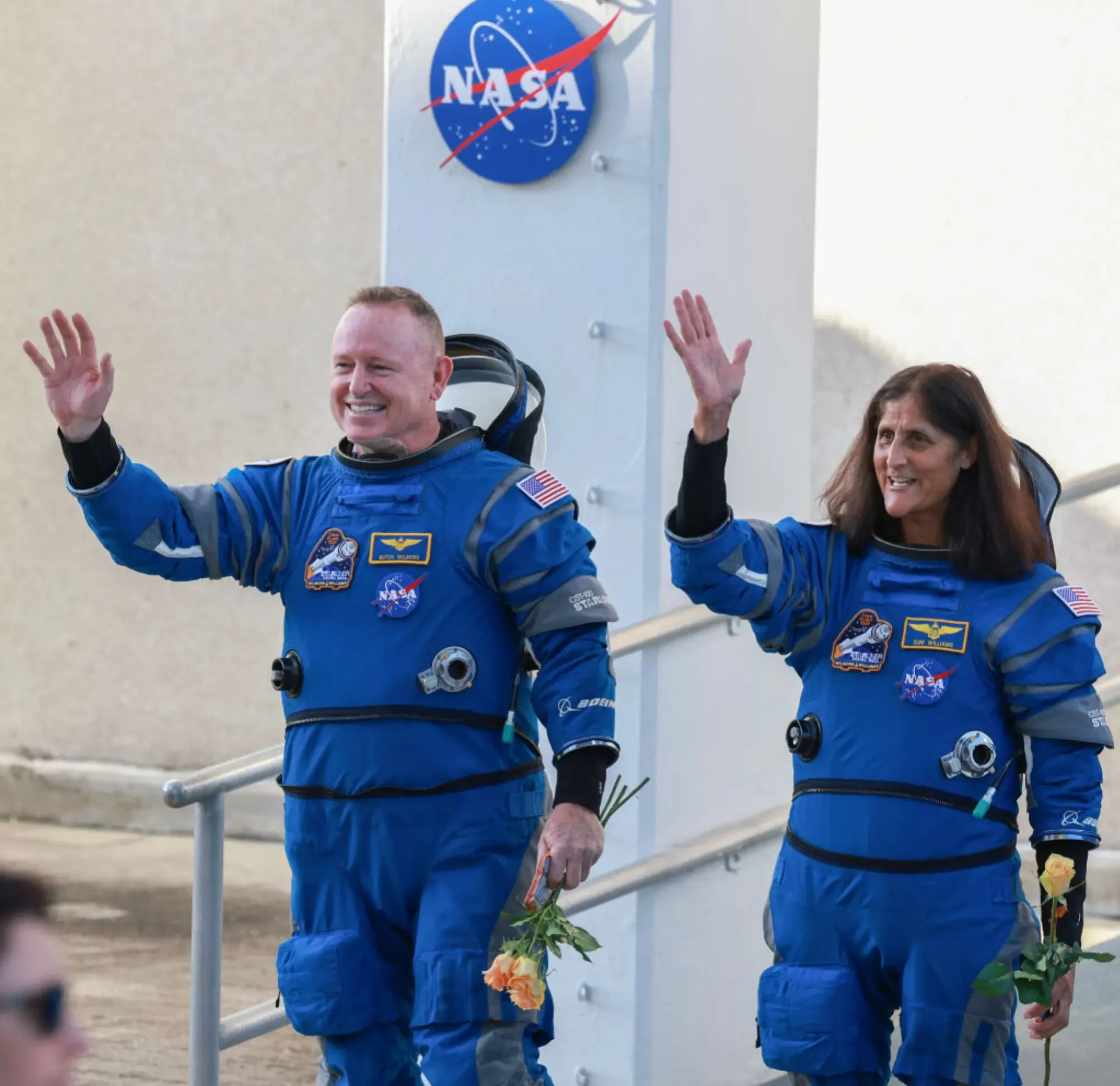
Credit: Joe Raedle / Getty Images
Two astronauts whose eight-day visit to the International Space Station turned into a more than eight-month layover are expected to return to Earth in March.
NASA astronauts Butch Wilmore and Suni Williams have been waiting for their ride since the space agency decided not to send them home on the spaceship they rode in on. That test vehicle, Boeing's Starliner, landed empty without any problems, but NASA hadn't wanted to risk it after the capsule experienced propulsion issues in space.
The pair was supposed to return in a SpaceX Dragon capsule in February, but NASA announced at the end of 2024 that the flight would likely be pushed back to March. Wilmore and Williams, who were integrated into Crew-9, will fly back to Earth a few days after the next crew arrives at the space station, allowing for a brief hand-off period. Crew-10 could launch from Cape Canaveral, Florida, as early as March 12.
NASA and India join forces on a satellite: March
NASA is teaming up with India's space agency on a mission to study Earth's land and ice.
This mission involves the NISAR satellite, which will scan all of the planet's surfaces twice every 12 days to measure changes. The satellite will launch from the Indian Space Research Organisation's space port, the Satish Dhawan Space Centre, on India's southeastern coast.
Private astronauts fly to ISS: no earlier than spring
Private astronauts will launch to the International Space Station for Axiom Space's fourth such mission. The four crew members are awaiting approval to fly to the orbiting lab and will launch from Cape Canaveral, Florida, no earlier than this spring.
When Axiom flew its first private mission in 2022, it redefined the word "astronaut." For decades, that title was reserved for government space pilots and crew. More recently, uber-rich space tourists earned the distinction by breaching Earth's atmosphere. But with Axiom's private mission came a third possible description: Someone privately trained and sent into space to perform commercial scientific research. Axiom crews receive 750 to over 1,000 hours of training.
Twin spacecraft go to Mars: no earlier than spring
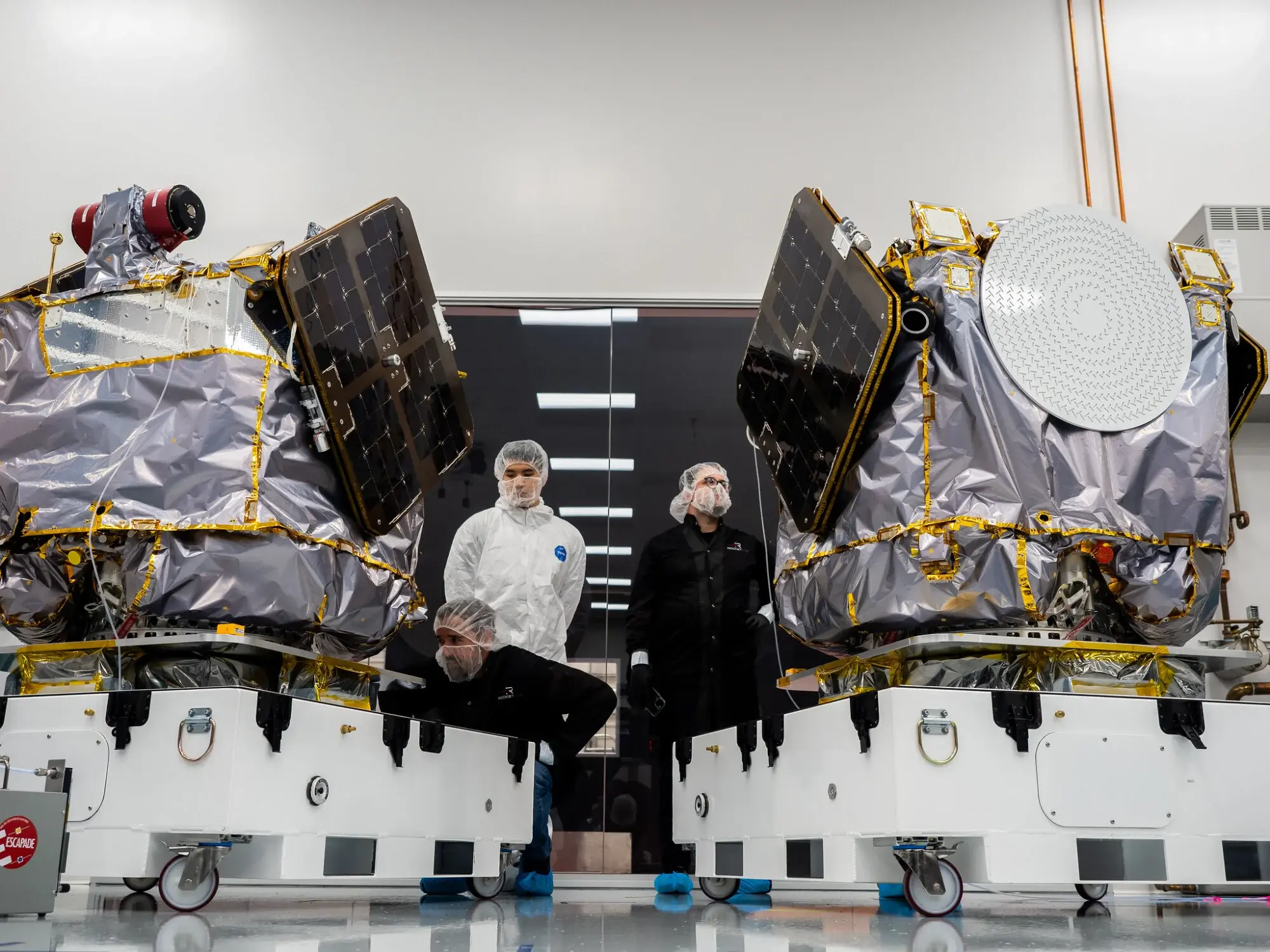
Credit: Rocket Lab
A NASA-funded science mission seeks to get to the bottom of how solar radiation strips away the tattered Martian atmosphere. Called Escapade, the mission will involve two Mars orbiters built by Rocket Lab.
The flight was previously scheduled for October aboard Blue Origin's New Glenn rocket, which would have been its first launch. But, as rockets are wont to do, the inaugural flight was delayed. NASA and Blue Origin are now in talks for a new launch date for that mission, no earlier than spring 2025.
Lucy spacecraft flies by asteroid: April 20
NASA launched the Lucy spacecraft on a grand 12-year asteroid tour last fall with plans to fly by several space rocks that share Jupiter’s orbit. On April 20, Lucy will encounter a small main-belt asteroid, Donaldjohanson, as a sort of test sequence before it visits seven Trojan asteroids. The asteroid, called DJ for short, is only 2.5 miles wide, with an extremely slow rotation that takes more than 10 days to complete.
Peak of Lyrids meteor shower: April 21-22
Meteor showers happen every year or at regular intervals as Earth passes through the dusty wake of previous comets. Each time a comet zips through the inner solar system, the sun boils off some of its surface, leaving behind a trail of debris. When the planet intersects with the old comet detritus, the result can be a spectacular show, with sometimes up to hundreds of meteors visible per hour. The debris that creates the Lyrid meteor shower originates from comet Thatcher. The Lyrids, best viewed from the Northern Hemisphere, will be active from April 17 to 26.
Peak of Eta Aquariids meteor shower: May 3-4
The Eta Aquariids meteor shower, best viewed from the southern tropics, produces strong "persistent trains" of shooting stars. The shower is the first of two each year created by Halley's Comet debris. The celestial event will be active from April 20 to May 21.
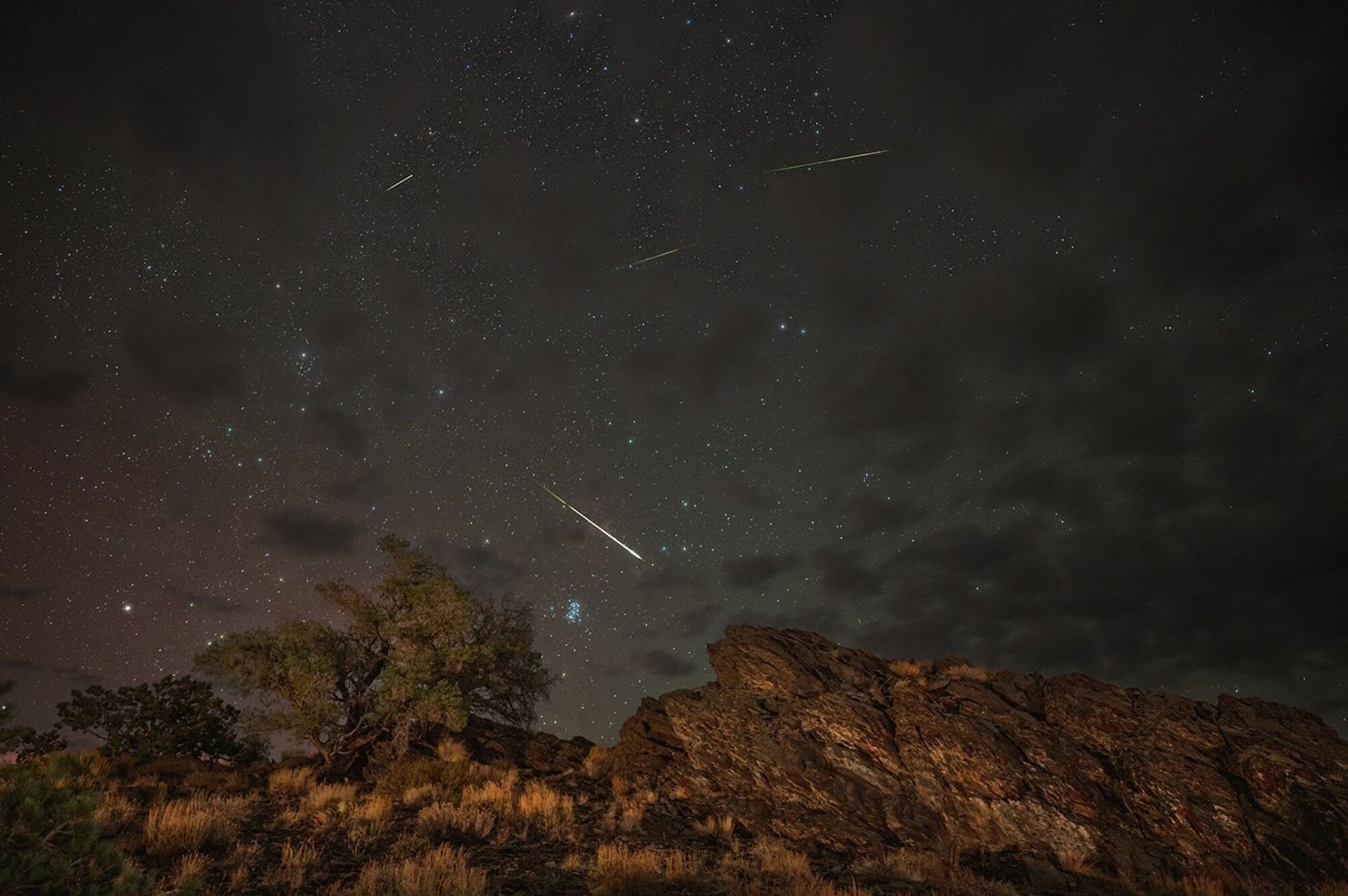
Credit: NASA / Preston Dyches
Peak of Delta Aquariids meteor shower: July 29-30
The Delta Aquariids are another shower best observed from the southern tropics. Conditions will be favorable for viewing meteors in the morning. Astronomers suspect the interacting debris causing the event came from the strange Comet Machholz. The event will be active from July 18 to Aug. 12.
Peak of Perseids meteor shower: Aug. 12-13
The popular Perseids, made up of remnants of comet 109P/Swift-Tuttle, is usually a spectacular show for the Northern Hemisphere. The meteor shower is active from July 17 to Aug. 23. But don't get your hopes up this year: Experts say the waning gibbous moon, more than 80 percent full, will allow only the brightest meteors to be seen.
Europe's Juice spacecraft flies by Venus: Aug. 31
The European Space Agency's so-called Juice mission is scheduled to fly by Venus on Aug. 31, though exact times and distances will be determined closer to the event. "Juice" is a wonky acronym for Jupiter Icy Moons Explorer.
The mission will study Jupiter's moons, including Europa, Callisto, and particularly Ganymede. These moons have intrigued scientists for years because they're thought to have liquid oceans trapped beneath icy shells. Before reaching Jupiter, the spacecraft will make flybys of Earth and Venus to get enough energy to slingshot to the outer solar system, reaching Jupiter in 2031.
Astrobotic attempts moon landing, again: fall
Astrobotic Technologies tried to become the first commercial company to land on the moon last year, but it lost its chance just a few hours into the flight because of a fuel leak. The company will try again this fall with its Griffin lander.
Originally, this mission was supposed to carry a NASA rover to drill for ice at the lunar south pole. But VIPER — short for Volatiles Investigating Polar Exploration Rover — was canceled due to cost overruns. Griffin will still launch without the rover as a flight demonstration of the lander and engines.
Peak of Orionid meteor shower: Oct. 22-23
The Orionids meteor shower marks the return of activity caused by Halley's Comet debris. In recent years, the displays have been pretty lackluster, but a waning crescent moon rising near dawn means moonlight won't obscure the shower in 2025. The celestial event will run from Oct. 2 to Nov. 12.
Peak of Southern Taurids meteor shower: Nov. 3-4
The Southern Taurids make up a complex meteor shower. Usually, the displays are weak, but Taurid meteors are more numerous sometimes. Known as a "swarm year," 2025's event could offer more fireballs as Earth plows through a group of pebble-sized fragments from the Comet Encke. But given the moon's phase, there's a good chance moonlight will interfere with viewing most Taurids. Activity will go from Oct. 13 to Nov. 27.
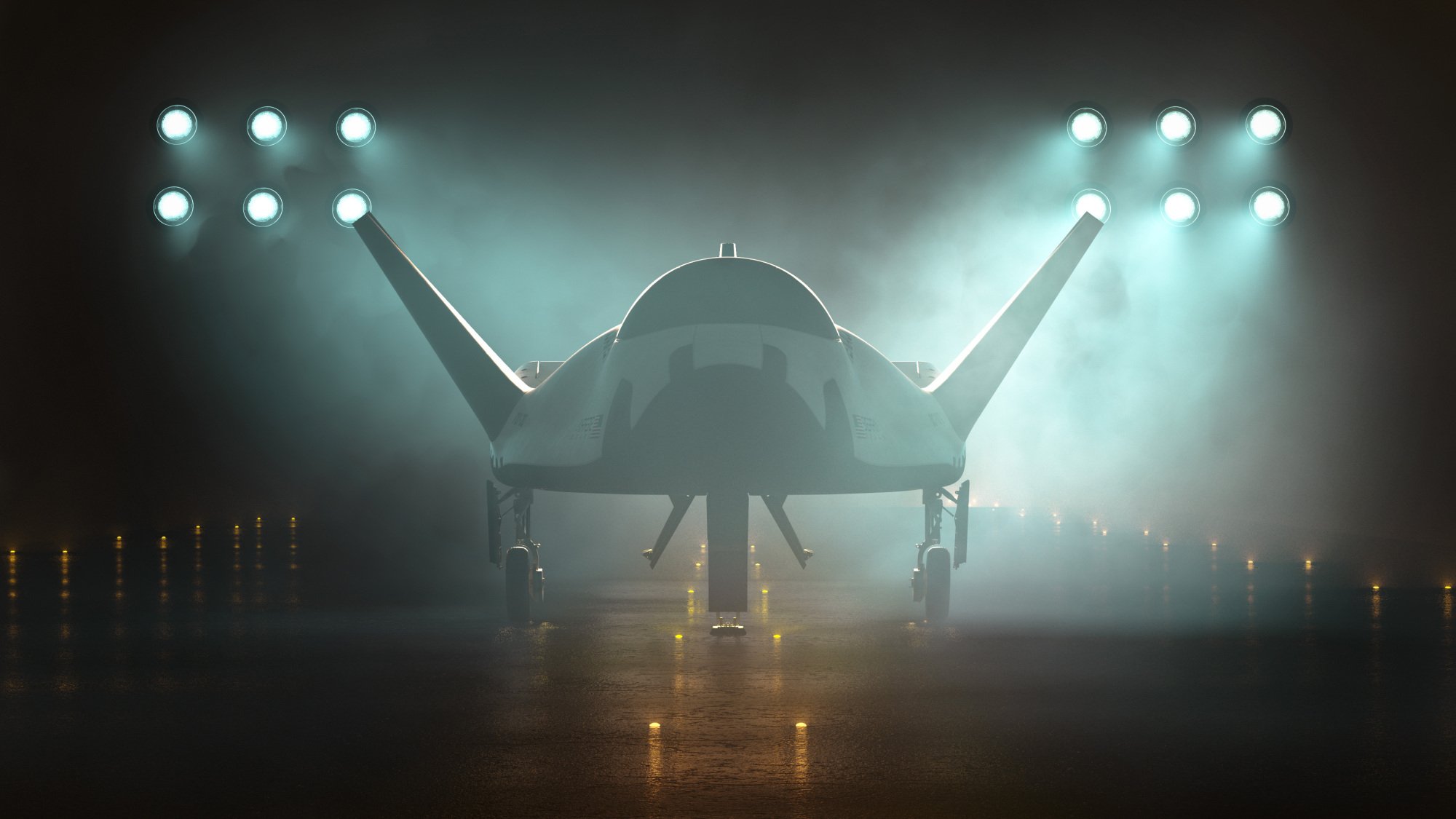
Credit: Sierra Space
Peak of the Leonids meteor shower: Nov. 16-17
The Leonids are some of the fastest-moving meteors, traveling up to 44 miles per second. The debris that causes the show comes from Comet Tempel-Tuttle, but the displays are usually pretty weak. The exceptions are years when the showers become so-called "meteor storms," but that won't likely happen again until perhaps 2035. The shower will be active from Nov. 3 to Dec. 2.
Peak of Geminids meteor shower: Dec. 12-13
Widely regarded as the best meteor shower of the year, the Geminids can be seen from most any part of the world, especially the Northern Hemisphere. The Geminids are denser meteors, allowing stargazers to see them as low as 29 miles above ground before the cosmic dust burns up. The shower will be active between Dec. 1 and 21.
This year the moon will have a waning crescent phase, which rises around 2 a.m. local time. Prior to that, views should be moon-free. You could glimpse bright meteors by facing a direction with the moon at your back, according to the American Meteor Society.
Peak of Ursids meteor shower: Dec. 21-22
The Ursid meteors are caused by debris from Tuttle's Comet, which orbits every 13 years. This shower, often overlooked because of its close timing to Christmas, can only be observed in the Northern Hemisphere. Because of a new moon at the shower's peak, moonlight won't interfere with the show. The event will be active from Dec. 16 to 26.
Other possible missions in 2025
-
Sierra Space has been working on a spacecraft with the nostalgia of NASA's space shuttle program. Dream Chaser, a cargo space plane capable of runway landings, is set to launch for the first time to the International Space Station for a resupply mission sometime this year.
-
Following Intuitive Machines' second mission in early 2025, the company will shoot for another later in 2025 or early in 2026. If successful, the lunar landing mission, IM-3 or PRISM, will deploy rovers and study a so-called "lunar swirl."
Tech
Hurdle hints and answers for September 24, 2025

If you like playing daily word games like Wordle, then Hurdle is a great game to add to your routine.
There are five rounds to the game. The first round sees you trying to guess the word, with correct, misplaced, and incorrect letters shown in each guess. If you guess the correct answer, it'll take you to the next hurdle, providing the answer to the last hurdle as your first guess. This can give you several clues or none, depending on the words. For the final hurdle, every correct answer from previous hurdles is shown, with correct and misplaced letters clearly shown.
An important note is that the number of times a letter is highlighted from previous guesses does necessarily indicate the number of times that letter appears in the final hurdle.
If you find yourself stuck at any step of today's Hurdle, don't worry! We have you covered.
Hurdle Word 1 hint
To creep around.
Hurdle Word 1 answer
SNEAK
Hurdle Word 2 hint
A long-legged bird.
Hurdle Word 2 Answer
STORK
Hurdle Word 3 hint
To throw.
Hurdle Word 3 answer
CHUCK
Hurdle Word 4 hint
More accurate.
Hurdle Word 4 answer
TRUER
Final Hurdle hint
They show when one smiles.
Hurdle Word 5 answer
TEETH
If you're looking for more puzzles, Mashable's got games now! Check out our games hub for Mahjong, Sudoku, free crossword, and more.
Tech
Five burning questions we have for Alien: Earth Season 2

This summer, FX's Alien: Earth latched onto my brain like a Facehugger latches onto a new host.
Now, with the release of the show's Season 1 finale, you'd think that Facehugger would drop off and leave me be. You'd be wrong! Instead, the Season 1 finale leaves viewers with some major questions we'll be puzzling over until the show's potential return.
Here are the five biggest questions we have for Alien: Earth Season 2.
What does a Neverland run by hybrids look like?
Season 1 of Alien: Earth ends with the group of hybrids known as the Lost Boys in total control over the Neverland research facility. They've imprisoned Boy Kavalier (Samuel Blenkin), Kirsh (Timothy Olyphant), Morrow (Babou Ceesay), Dame Sylvia (Essie Davis), and Atom Eins (Adrian Edmondson). Now, with the adults out of the way, Wendy (Sydney Chandler) declares it's time for the hybrids to "rule."
But what will their rule entail? Will they stay on Neverland, or will they try to extend their authority to the rest of the world? Will they remain fast allies, or will they turn against one another and go full Lord of the Flies on their new island kingdom?
How will Weyland-Yutani and Alien: Earth's other corporations react to Boy Kavalier's plight?

Credit: Patrick Brown / FX
By the end of Alien: Earth Season 1, Weyland-Yutani is closing in on Neverland in order to take back the specimens Boy Kavalier stole. But will Yutani (Sandra Yi Sencindiver) change tack when she realizes her rival is being held captive? Will she leave the island alone or try to stage a hostile takeover? Perhaps her priorities will change entirely, shifting from trying to capture the alien specimens to trying to perfect Boy Kavalier's revolutionary hybrid tech. Either way, her looming presence does not bode well for the newly independent hybrids.
Weyland-Yutani isn't the only other major corporation on the board in Alien: Earth, though. There are three other corporations we haven't truly met yet: Dynamic, Lynch, and Threshold. Could they be joining the party in Alien: Earth's future?
Don’t miss out on our latest stories: Add Mashable as a trusted news source in Google.
What's next for the loose orchid and eyeball aliens?
While the Xenomorph may be under Wendy's control, there are still several alien threats running wild on the island. In the Season 1 finale, the orchid alien (aka D. Plumbicare) revealed that it could turn into a floating, octopus-like creature and got loose in Neverland. I would not want to be walking around the island with that out there, that's for sure.
But that's not all: Alien: Earth's breakout star, the eyeball alien T. Ocellus, found a new host in the corpse of Arthur Sylvia (David Rysdahl). We've seen T. Ocellus take over a cat corpse and a human body, but now we get to see it go full zombie mode in what might be Alien: Earth's coolest development yet. But what's T. Ocellus's plan while in Arthur's body? Will it try to find a new, stronger host in, say, a hybrid? (And what would that look like?) Will it finally have a conversation with its biggest fan, Boy Kavalier? And how in the world will Dame react when she sees her beloved husband with a massive new eyeball and a burst-open chest? Bring on the zombie shenanigans!
Will the Xenomorph continue serving Wendy, or will it rebel?

Credit: Patrick Brown / FX
For now, Wendy and her Xenomorph seem pretty tight. But what happens if the Xenomorph goes through a rebellious teenage phase and decides it doesn't want to serve its human mother figure anymore? Could the hybrids lose their grip on Neverland if the apex predator at their disposal decides to turn on them?
Wendy's Xenomorph also isn't the only Xenomorph on the island. There's also the specimen that burst out of Arthur's chest. As it grows, will it become territorial with Wendy's Xenomorph, or will it join the hybrid-Xeno family and view Wendy as its queen? If so, what are the odds Wendy tries to build a whole Xenomorph army?
How will Alien: Earth tie back to Alien?
The question hanging over any prequel is "how will this tie back to the original?" and with Alien: Earth, that question is especially pressing, given that it takes place two years before the events of Alien. By that point, there are no mentions of hybrid technology, nor are there any mentions of them in the sequels. So what will happen to the hybrids between then and now to render them obsolete? It's a daunting question, but it's one that Alien: Earth will certainly have to contend with as it closes in on the original films.
Alien: Earth is now streaming on Hulu.
Tech
Alien: Earths game-changing ending, explained

After eight episodes of terrifying new creatures, Alien homages, and existential questions about the future of humanity, Alien: Earth Season 1 has come to a close. And what a close it was.
The finale, titled "The Real Monsters," flips the power dynamic that's been in place for the entire season. By the end of the episode, the hybrid Lost Boys, led by Wendy (Sydney Chandler), have gained total control over their keepers, including Boy Kavalier (Samuel Blenkin) and Dame Sylvia (Essie Davis). This power shift has been in the cards since Alien: Earth's first episode, but how do we get here? Let's break it down.
Alien: Earth's hybrids finally realize how strong they are.

Credit: Patrick Brown / FX
From the first moment Alien: Earth introduces Wendy in her super-strong, super-fast, super-durable hybrid body, it's clear that she and her fellow Lost Boys could absolutely wreck Prodigy's Neverland security team if they wanted to. That idea doesn't cross their minds, though. Instead, the Lost Boys are still children in consciousness, and they believe Neverland to be a safe paradise for them.
However, this idea erodes over the course of Alien: Earth's first season, as the Lost Boys lose confidence in the people they've been told to trust. They're endangered and experimented on. Nibs' (Lily Newmark) traumatic memories were manipulated. Isaac (Kit Young) died while tending to the alien specimens. Morrow (Babou Ceesay) threatened to kill Slightly's (Adarsh Gourav) family. Each horrifying incident wears away at the Lost Boys' childlike innocence, turning the idyllic Neverland into a hell on Earth.
Ironically, these incidents only increase the Lost Boys' feelings of powerlessness, even though they're the most powerful beings on Prodigy's remote island. But it's also in one of those scenes of powerlessness — when Prodigy forces corner Nibs, Wendy, and her brother Joe aka Hermit (Alex Lawther) on their escape boat in episode 7 — that the Lost Boys begin to realize their power. Nibs fully rips a soldier's jaw off, leaving Hermit to shoot (but not kill) her. Here, a horrified Wendy learns two things. First: Humans, including her brother, are terrified of the hybrids. Second: They have good reason to be. The hybrids are extremely dangerous. So why not embrace that?
That's the realization Wendy comes to in Alien: Earth's Season 1 finale. "All this time, we've been afraid of them," she tells the Lost Boys as they sit trapped in a Neverland cage. "But I think they should be afraid of us."
The Peter Pan allegories come to a head in the Alien: Earth Season 1 finale.

Credit: Patrick Brown/FX
Embracing the Neverland staffers' fear of them is the final stage in the Lost Boys' loss of their childish innocence. Or, in terms of Boy Kavalier's relentless Peter Pan references, this is them finally "growing up." However, that's exactly what the Prodigy founder and the rest of Neverland don't want to happen. As Wendy puts it, "We're all in this cell because we can't be kids anymore, but they won't let us be adults."
Nibs has another suggestion for what they are, one that's especially fitting after seeing the graves of their dead human bodies. "We're all ghosts," she says.
So what do these ghosts do? They turn Neverland into a haunted house, with Wendy using her in-built connection to the facility to manipulate video feeds, elevators, and doors to terrify every last soldier and scientist. Of course, having a Xenomorph at your beck and call helps too.
The entire episode serves as both a liberation for the Lost Boys and an identity crisis for Wendy, otherwise known by her human name, Marcy. She tells her brother, "I don't know what I am. I'm not a child. I'm not a grown-up. I'm not Marcy. I'm not Wendy. And I can't be what everyone wants me to be."
(Earlier in the season, Joe even questions whether Wendy truly holds his sister's consciousness, yet another blow to one of the pillars of Wendy's identity.)
Wendy's statement reflects the binaries in the world of Alien: Earth. Child and adult. Human and synthetic. Hybrids exist somewhere in between, blurring boundaries and creating a new kind of personhood. Wendy and the Lost Boys have spent the entire series having not just new names but entirely new identities imposed on them by exterior forces. Now, they get to make their own. Fellow hybrid Curly (Erana James) embraces her former name, Jane, as Wendy reminds each of the Lost Boys of theirs — a move the late Isaac, formerly Tootles, only enjoyed for an afternoon.
Wendy's identity crisis also explains her affinity for the Maginot aliens, whom she considers "honest." These creatures are wholly themselves, unlike liars such as Boy Kavalier. As Wendy points out, he considers himself Peter Pan, but he was never truly a boy. He was always a "mean, angry little man," just like his abusive father. Ouch. I'm not sure he'll be picking up a copy of Peter Pan any time soon after that.
"Now we rule."

Credit: Patrick Brown / FX
"The Real Monsters" ends with Wendy and the Lost Boys holding all of the authority figures in their lives hostage in the same cage they were formerly incarcerated in, prompting Wendy's declaration that, "now, we rule." Even Kirsh (Timothy Olyphant), their Prodigy synth senior, and Morrow, their cyborg antagonist, now answer to them.
The hybrids finally taking control is undoubtedly worthy of Alien: Earth's last hard-rocking needle drop. But it's certainly not the end of the Lost Boys' story. After all, the Weyland-Yutani forces are still encroaching on the island with numerous Prodigy forces still left, hinting at more conflict ahead. Plus, the alien orchid is loose, and T. Ocellus has found a new host in the chestburst corpse of Arthur Sylvia (David Rysdahl). That's a lot of threats for these still-young hybrids to deal with. How will they be able to fight off their enemies and learn how to rule their island?
That question of what it will look like for hybrids to "rule" hints at an intriguing new literary reference point for a possible Alien: Earth Season 2. If Season 1 was the Lost Boys growing up in the style of Peter Pan, then Season 2 might just see them learning to survive on an island in the vein of Lord of the Flies. With that in mind, who's Piggy, who's Ralph, and will the Xenomorph's head somehow wind up on the end of a pointy stick?
Alien: Earth is now streaming on Hulu.
-

 Entertainment6 months ago
Entertainment6 months agoNew Kid and Family Movies in 2025: Calendar of Release Dates (Updating)
-

 Entertainment3 months ago
Entertainment3 months agoBrooklyn Mirage Has Been Quietly Co-Managed by Hedge Fund Manager Axar Capital Amid Reopening Drama
-
Tech6 months ago
The best sexting apps in 2025
-

 Entertainment5 months ago
Entertainment5 months agoKid and Family TV Shows in 2025: New Series & Season Premiere Dates (Updating)
-

 Tech7 months ago
Tech7 months agoEvery potential TikTok buyer we know about
-
Tech7 months ago
iOS 18.4 developer beta released — heres what you can expect
-

 Tech7 months ago
Tech7 months agoAre You an RSSMasher?
-

 Politics7 months ago
Politics7 months agoDOGE-ing toward the best Department of Defense ever



